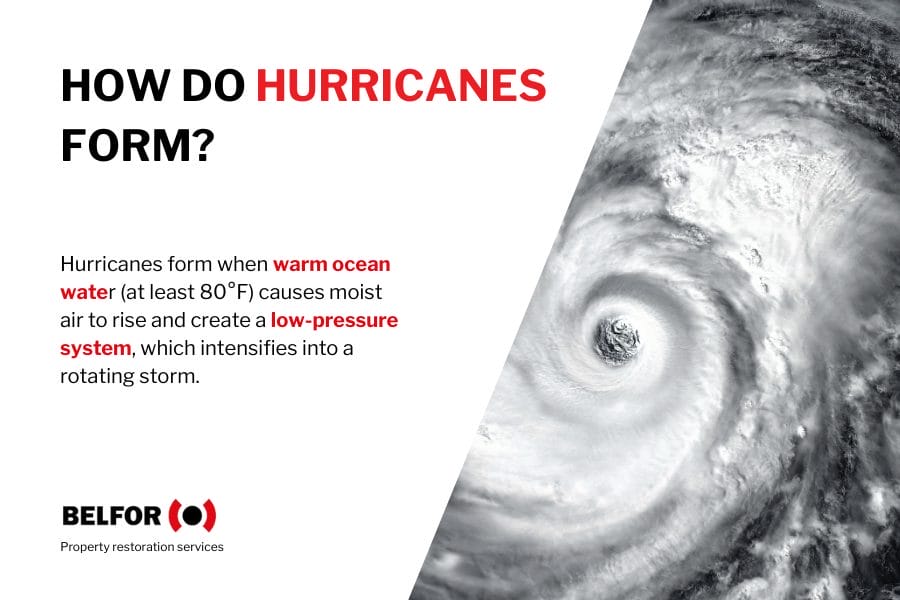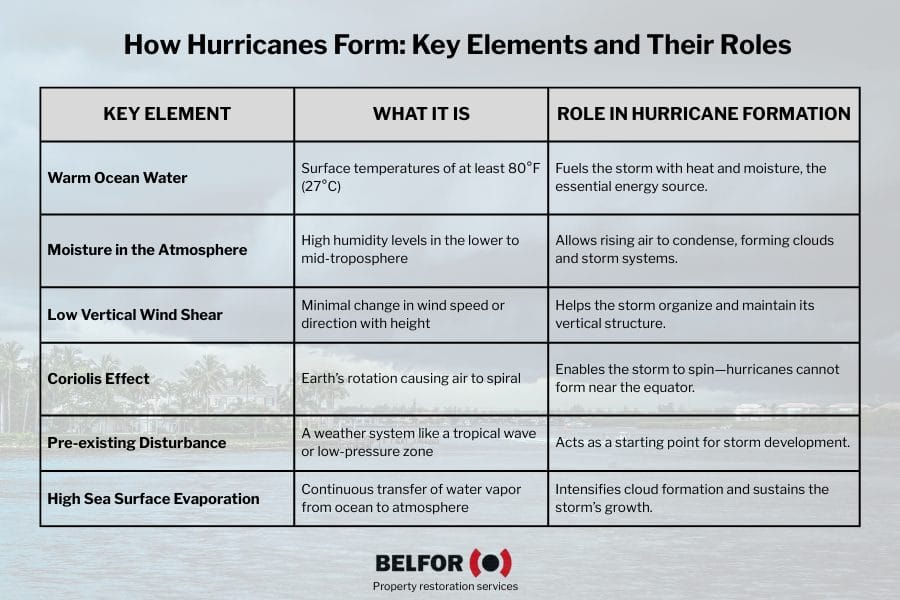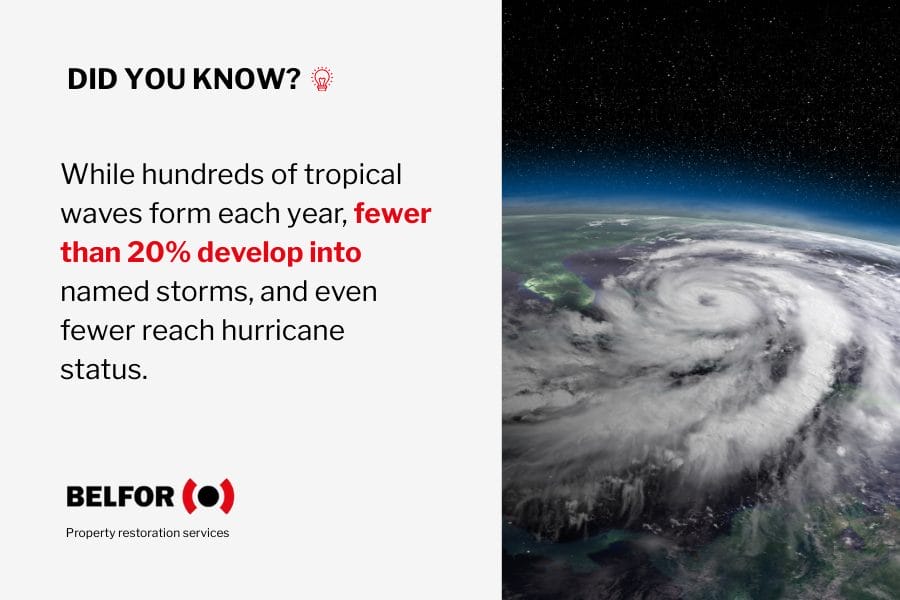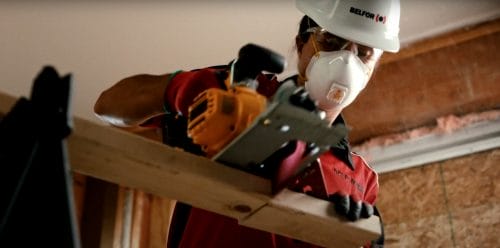How Do Hurricanes Form: From Ocean Heat To Storm Systems

How Do Hurricanes Form: Key Points
- Hurricanes form over oceans with surface temperatures of at least 80°F, providing the heat and moisture needed to power the storm
- A hurricane forms progressively, starting as a tropical disturbance, then a depression, followed by a tropical storm, and finally a hurricane once wind speeds reach 74 mph
- Hurricanes need the Earth’s rotation to develop their spin, which is why they don’t form near the equator, where the Coriolis effect is too weak
- Most hurricanes develop in warm-water zones known as “hurricane belts,” including the Atlantic Ocean, Gulf of Mexico, and Eastern Pacific, especially during peak hurricane season from June to November
The 2024 Atlantic hurricane season caused over $182 billion in damages across the U.S., with businesses and communities in high-risk regions hit hardest.
However, these strong storms follow a predictable, science-based path before they reach landfall.
Understanding how hurricanes form isn’t just for meteorologists; it’s essential for anyone looking to protect their property, prepare their business, and stay safe during hurricane season.
This guide will break down:
- The science behind hurricane formation
- Each stage of development, from disturbance to Category 5
- Why certain regions face more storm damage than others
- How understanding hurricane behavior helps businesses prepare in advance
How Do Hurricanes Form? The Science Behind It
Hurricanes form when a specific set of weather and ocean conditions come together.
Here’s what fuels their formation:
- Warm ocean waters (above 80°F or 27°C): Warm water acts as the energy source for hurricanes. When the ocean surface heats up, it increases evaporation. This sends moisture into the air and helps power the storm.
- Moisture and rising air: As warm, moist air rises, it cools and condenses into clouds. This condensation releases energy, which helps the storm system strengthen and grow.
- Low vertical wind shear: For a hurricane to form and stay organized, wind speeds and directions need to remain relatively consistent from the surface to the upper atmosphere. Strong wind shear can tear a storm apart before it develops.
- The Coriolis effect: Earth’s rotation causes moving air to curve, giving hurricanes their spiral shape. This effect is necessary for storm rotation, which is why hurricanes don’t form near the equator, where the Coriolis effect is weak or absent.
- Tropical disturbances: Most hurricanes begin as clusters of thunderstorms over warm ocean water. If conditions allow, these disturbances can evolve into different hurricane categories such as tropical depressions, tropical storms, and eventually full hurricanes.
Pro tip: Late summer is peak hurricane season because ocean temperatures are highest, increasing the risk of rapid storm formation and intensification.

The 5 Stages of Hurricane Forming
Understanding how hurricanes form helps you better prepare for what’s ahead. These powerful storms develop in stages, each with increasing intensity and risk.
Here’s a breakdown of how they evolve from stage 1 to stage 5.
Stage 1: Tropical Disturbance
A tropical disturbance is the earliest stage of hurricane development. It begins with a cluster of thunderstorms forming over warm ocean waters, typically above 80°F. The system shows limited rotation and lacks a defined center.
Why it matters: While not yet dangerous, tropical disturbances are closely monitored because they can rapidly strengthen under the right conditions.

Stage 2: Tropical Depression
When thunderstorms become more organized and winds reach up to 38 mph, the system becomes a tropical depression.
A low-pressure center begins to form, and rotation becomes more apparent.
What to know: Heavy rain and localized flooding may occur even at this early stage. Meteorologists issue updates to help communities prepare.
Stage 3: Tropical Storm
At this stage, the system is named and becomes a tropical storm. Sustained winds range between 39 and 73 mph.
The storm gains strength and circulation becomes more defined.
Potential risks: Power outages, flooding, and high surf conditions are likely. This is the time to finalize emergency supplies and stay alert for possible evacuation orders.
Stage 4: Category 1 Hurricane
Once sustained winds exceed 74 mph, the storm becomes a hurricane or it’s a straight line wind.
A visible eye forms in the center, and the storm structure becomes more powerful.
Damage level: Category 1 hurricanes can cause roof damage, power outages, fallen trees, and dangerous coastal flood damage.
Stage 5: Intensification to Category 5
If the storm remains over warm water and faces little wind interference, it can quickly intensify.
- Category 2: Winds between 96 and 110 mph
- Category 3: Winds between 111 and 129 mph
- Category 4: Winds between 130 and 156 mph
- Category 5: Winds above 157 mph
Why this stage matters: Stronger hurricanes bring higher storm surge, structural failure, and long-term recovery challenges
Where Do Hurricanes Form
Hurricanes don’t form randomly. They thrive in specific regions where the right environmental conditions align.
They typically form at:
- Warm ocean basins: Hurricanes need sea surface temperatures above 80°F to form and gain strength. That’s why most hurricanes develop over the Atlantic Ocean, Gulf of Mexico, Caribbean Sea, and the Eastern Pacific. These areas consistently reach the warm temperatures needed to fuel massive storms.
- Seasonal patterns: The Atlantic hurricane season runs from June through November, with peak activity usually in August and September. During these months, ocean temperatures are at their highest and atmospheric conditions are more favorable for storm development.
- Hurricane belts: Areas near the equator but at least 5° latitude north or south form what’s known as hurricane belts. These zones are more likely to experience storms due to the combination of warm water, moisture-rich air, and the Coriolis effect, which helps storms rotate and organize.
Why Not at the Equator?
Hurricanes rarely form directly at the equator because they require the Coriolis effect. It’s an Earth rotation phenomenon that causes spinning. This force is too weak at the equator to generate rotation, so storms typically develop farther north or south.
If you live along the Gulf Coast, southeastern U.S., or in Caribbean Island regions, you’re in one of the highest-risk zones for hurricane activity. Knowing your region’s vulnerability helps you prepare early.
Understanding Hurricane Behavior for Better Business Preparation
When it comes to protecting your business, understanding how hurricanes behave isn’t just a precaution; it’s essential.
Why Early Understanding Matters
Hurricanes can intensify rapidly and shift unpredictably.
Businesses that track storm development and understand hurricane behavior are better positioned to act early. Fast decisions come from informed preparation.
Pro tip: Start tracking weather alerts at the beginning of hurricane season and review your emergency response plan quarterly, not just when a storm is nearby.
Real-Life Commercial Disruption Examples
In 2017, Hurricane Harvey caused over $125 billion in damage, halting operations for thousands of businesses in Texas.
Many lacked flood plans or backup power. During Hurricane Ida in 2021, power loss across Louisiana created weeks of disruption. Companies that had prepared were the first to bounce back.
Pro tip: Look at past local hurricane events to anticipate the specific risks your business might face, like power, water damage in walls or ceilings and supply chain.
The Importance of Property Risk Assessments
Routine property assessments help identify weak points before a storm reveals them to you. Roof condition, drainage systems, and structural integrity are all critical areas that need to be reviewed.
A detailed assessment reduces costly surprises and supports faster insurance claims.
Pro tip: Schedule professional inspections ahead of hurricane season to evaluate roofing, windows, foundations, and backup systems. You should always prioritize repairs well before storms arrive.
How Does a Hurricane Form: Key Takeaways
- Early formation indicators matter: Spotting tropical disturbances early can provide crucial time to prepare.
- Business preparedness is vital: Knowing when and where hurricanes form helps reduce downtime and protect property.
- Hurricane behavior isn’t random: It’s the result of a combination of heat, moisture, wind, and rotation, conditions we can monitor and act upon.
- Storms can intensify fast: A tropical storm can become a major hurricane in a matter of days under the right conditions.
Trust BELFOR for Commercial Hurricane Recovery and Restoration
At BELFOR, we know hurricanes don’t just disrupt property; they disrupt operations, livelihoods, and the people behind them. That’s why businesses across the country trust our team to lead recovery efforts with speed, precision, and compassion.
With decades of experience in commercial restoration, we act fast to assess structural damage, remove water, and restore critical systems, all while minimizing downtime.
When you call BELFOR, you can count on:
- 24/7 rapid response: Our emergency teams mobilize quickly to limit damage and keep your recovery on track.
- Full-service restoration: From water removal to electrical repair, we handle everything in one seamless process.
- Industry expertise: We understand the unique needs of commercial operations, from healthcare and retail to manufacturing and government.
- Insurance coordination: Our specialists help document damage and navigate claims to streamline your financial recovery.
- Resilient rebuilds: We don’t just fix what’s broken; we help strengthen your property for what’s ahead.
.jpg)


